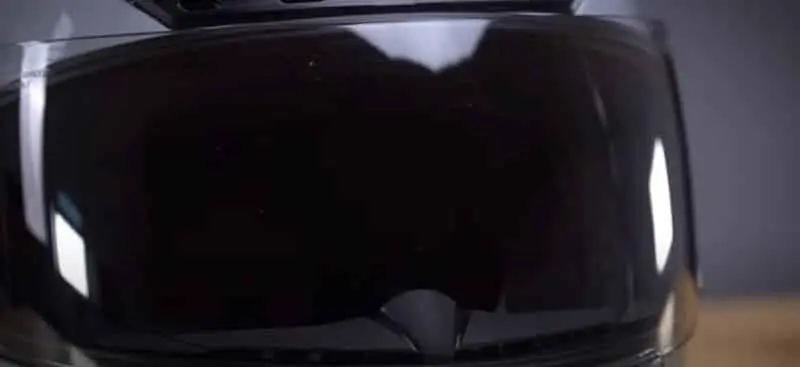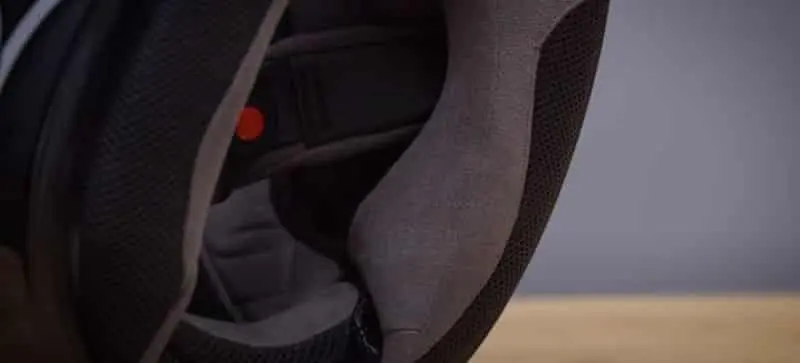Bell’s qualifier DlX MIPS is a sporty street helmet with a couple of standout features and a reasonable price tag. It’s hard not to start with the visor that changes from clear to tinted when exposed to daylight.
It also has a MIPS liner inside, which is an extra safety that you won’t even know is there in everyday use, but it might turn out to be a big help if everything goes horribly wrong one day.
Is The Bell Qualifier That Good?
Table of Contents
Shell Construction
The Bell qualifier DlX MIPS runs a plastic shell, and the whole helmet weighs in at 1600 grams for this size medium on our scales. That’s a bit above the average for a sports helmet, but it’s not too bad and doesn’t feel heavy when riding.
Ventilation
There are vents through the chin bar and then two sets above the visor. The chin vents channel air through two slash cuts on the chin bar’s inside and a series of small slits on the upper surface of the chin bar, which directs some air to the visor.
There are four vents immediately above the eye-port, which gives a direct flow of air through the eps to give you a cooling effect on your head. And then, on top, two sliding vents reveal holes that reach down into the helmet interior.
The two vents on the top of the helmet allow hot air to rise from the interior pulling air through the scoop over the top of the helmet and exiting through the exhaust ports on the rear of the helmet.
The chin vent and forehead vents drew a noticeable amount of air through the helmet. The one on top was less pronounced than its effect, but I’d expect it, as it’s designed to draw warm air away from the inside rather than send cold air flowing inside.
Is Bell Qualifier Pinlock?

The Bell Qualifier doesn’t come with a pinlock as it has its anti-fogging system. This is probably the best thing about this helmet, and if that sounds like a criticism of the rest of the lid, then I don’t mean it to be.
At night this visor is perfectly clear as it is when you are indoors. But if you take it out in the daylight, it reacts straight away to UV light tinting to the point where it goes as dark as a race visor.
It doesn’t have to be bright sunshine outside for it to react; even on cloudy days, there’s enough UV light to make it go dark.
If there is even mild criticism from me, it can go a little darker than I would have liked for some conditions. But, not once in my time with this helmet did I find my vision to be a problem because of the level of tint.
Having a visor like this does away with the need for an internal sun visor. It’s slightly less flexible than having a sun visor, as you can lift one of those out of the way, but personally, I would rather have a light reactive visor than deal with the extra weight.
This is the best solution to riding in differing light conditions, and I hope it’s not too long before all helmets come with light reactive visors like this.
This one is also anti-fog coated, which does away with the need for a pin lock insert on the inside. However, I found this one wasn’t quite perfect with all the fog-coated visors I’ve ever used.
It doesn’t fog as such, but if I leave it without airflow for long enough, the moisture from my breath will capture in the coating, creating a muscled effect on the inside of the visor that makes things look a little bit blurry. Lifting the visor will get some air on it, soon clearing that moisture away.
Nothing is perfect for preventing visor fogging, even a pin lock. A pin lock is more effective than a coating like this one.
It will be better when the weather gets nasty, but the only time I found this one to struggle was when I was riding slowly around town in the rain.
So if you want something for all-year riding and all-weather, then I think a pinlock-protected visor will be better for you, but I would expect this to work well for most riding conditions.
This helmet isn’t trying to be an all-weather, all-year riding helmet, so I’m not criticizing it. I’m just pointing out what I would expect from it and what I wouldn’t expect from it.
The lifting and lowering mechanism for the visor are very simple, and there are only really three stages. So first, you’ve got fully open, fully closed, and then a visor clearing position.
A smaller cracked position to stop it from fogging up would be handy, but you can’t have everything.
It’s really simple to change the visor; it takes about 10 seconds, and that’s without even rushing. So there’s one thing that I will say about this visor: there’s a massive financial incentive to look after it.
If you need a new visor, it will cost you over $200. At that price, sometimes it’s cheaper to buy a whole helmet in a clearance sale than it is to buy just the new visor.
Keep it clean using only water and clean dust-free cloths to wipe it down. Never use any form of cleaner on the coated inner surface, as you will probably wreck that coating and make the visor unusable.
If I had one of these lids, I’d consider keeping it in the bag when I’m not using it to ensure it doesn’t gather a load of dust on the surface that can scratch it.
Interior

The foam lining is fully removable, and it’s covered with nice brushed material. I think of that as being a bit more road-friendly, and I would expect it to get a bit warm inside if I was using it for intense track riding.
What is MIPS on Bell Helmets?
The pads all fit in there neatly, and behind the pads is the safety benefit I mentioned at the start, and that’s because this helmet has a MIPS liner.
A MIPS liner is a yellow layer that sits on the inside of the helmet and is attached to the EPS impact liner with some flexible bands.
The principle is that the liner will allow your head to move very slightly inside the helmet if you suffer a glance and blow in an accident.
Nature has its own equivalent, and it’s called the scalp. It slides over your head if you fall over, reducing the deceleration forces you experience inside your head.
MIPS works similarly; it helps control the deceleration rate inside your head.
It’s there to do a job if I’m ever unlucky enough to need it, but I’ve got no idea that it’s in there for the rest of the time.
Intercome Speaker Sockets
Behind all of those linings, there are recesses for intercom speakers. I fitted in a pair of 40-millimeter speakers, which fitted in quite neatly.
You can stick your speakers direct to the EPS; there are also handy pockets in the cheek pads that open up and wallow the speakers. It’s a little bit easier than attaching them to the helmet.
This helmet comes with a D-ring fastener; there’s also a chin curtain to reduce draughts and noise.
If you find your visor getting a bit blurry, it’s worth trying the lid with the chin cone out, as that will help the moisture from your breath escape through the bottom of the helmet rather than gathering on the inner surface of the visor.
Available Sizes
The Bell Qualifier DLX MIPS comes in sizes from extra small to double extra large. There are three shell sizes available.
The smallest covers helmet sizes extra small and small-medium. Large-sized helmets share their shell size, and then XL and above go into the biggest shell.
Is The Bell Qualifier Snell Or DOT Approved?
The Bell Qualifier MIPS helmet is DOT, and ECE certified and has been tested to meet the standards of the Snell Memorial Foundation.
The helmet is constructed of ultra-lightweight polycarbonate and features three sizes, SM, MD, and LG.
This helmet’s approved to ECE2205 for the road, and it’s also ACU gold so that you can wear it on circuits here in the UK. It also scored three stars out of five when tested for the UK government’s sharp impact testing program.
For me, the strongest appeal to this helmet is the light-reactive visor. Of course, not having to mess about with some visors or swap from a dark visor to a clear visor depending on the time of day is a real plus point, but the rest of the helmet is also good.
If you’re not looking for something that will excel in prolonged wet weather riding, I think the Bell Qualifier DLX MIPS is a decent option.
In Conclusion
The Bell Qualifier DLX MIPS motorcycle helmet is a lightweight impact protection helmet that features MIPS Multi-Directional Impact Protection System for dramatically improved rotational impact energy displacement.
It also includes an adjustable ventilation system, moisture-wicking interior, contoured cheek pads, and an integrated speaker pocket.
The helmet also features a breath deflector, chin curtain, and click-release shield change system.
Where To Buy
| Brand | Revzilla | Sports Bike Shop |
|---|---|---|
| Bell Qualifier DLX MIPS | $279 to $289 | £169 to £209 |


